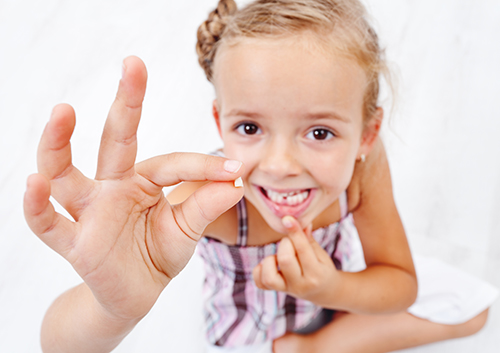February 5th, 2025

February is National Children’s Dental Health Month, and a perfect time for Dr. Jason Rector to review some of the important steps in keeping your child’s smile healthy!
Your Baby
Early care is best! Even before teeth appear, the American Dental Association recommends gently wiping your baby’s gums with a clean, moist gauze pad or washcloth after feeding. When his or her first tooth arrives, it’s time to schedule your child’s first visit. Our office will be happy to answer any questions you might have about brushing tools and techniques. This is also an opportunity to check not only tooth health, but jaw and teeth development. Check your baby’s teeth regularly, and call us if you have any concerns.
Your Preschooler
By the time children are three, they will probably have all or most of their baby teeth. Brushing your child’s teeth twice a day with a soft-bristled, child-sized brush is a great model for when your child begins brushing on his or her own. And when teeth begin to touch, flossing your child’s teeth is recommended once a day as well. Remember to schedule regular checkups at our Ocean Springs office, and help make your toddler’s visit positive by reading books or watching videos about visiting the dentist, using playtime to practice things that might happen in the dentist’s chair (such as opening his or her mouth to count teeth), and planning visits during times your child is well-rested.
Your School-Age Child
Your child might be ready to take on brushing and flossing while you supervise, and there are many ways you can encourage both reluctant and enthusiastic brushers! The ADA recommends two minutes of careful brushing twice a day, or as directed by your dentist or physician. You can use these four important minutes to tell your child stories, listen to music, or brush together. Your child can help choose his or her toothbrush and toothpaste, or earn stickers for a brushing job well done. Stick to a routine for best results, and schedule regular checkups and cleanings to protect your child’s overall dental health. This is also an important age to check bite alignment, any potential orthodontic issues, and the possibility of sealants.
February might be the shortest month, but it’s a great time to consider your child’s life-long smile. If you have any questions or concerns, the team at our Ocean Springs office is always happy to discuss them with you—any time of year!
January 29th, 2025

While the last baby teeth generally aren’t lost until age ten or 11, most children stop believing in the tooth fairy by the time they're seven or eight. Of course, children are more than happy to play along with the game when there’s money at stake! While it is impossible to know what the tooth fairy does with all those teeth (are they labeled and stored like museum pieces in a giant fairytale castle?), it is possible to trace the history and myth of the tooth fairy to several cultures and traditions. Dr. Jason Rector and our team learned about some interesting myths about the tooth fairy!
The Middle Ages
Legend has it that Europeans in the Middle Ages believed a witch could curse someone by using their teeth, so it was important to dispose of baby teeth correctly. Teeth were swallowed, buried, or burned. Sometimes baby teeth were even left for rodents to eat. Despite being pests, rodents were valued for their strong teeth; it was generally believed a tooth fed to a rodent would lead to the development of a healthy and strong adult tooth.
Eighteenth Century France
The tooth fairy myth began to show more characteristics of a conventional fairytale in 18th century France. La Bonne Petite Souris, a bedtime story, tells the strange tale of a fairy that changes into a mouse to help a good queen defeat an evil king. The mouse secretly hides under the evil king’s pillow and defeats him by knocking out his teeth.
Scandinavian Lore
So, why does the tooth fairy leave money under the pillow? The idea of exchanging a tooth for coins originated in Scandinavia. Vikings paid children for a lost tooth. Teeth were worn on necklaces as good luck charms in battle. While the idea of exchanging a tooth for coins quickly spread throughout the rest of Europe, a fierce, horn-helmeted Viking is far cry from the image of a fairy collecting teeth.
While the tooth fairy as children know her today didn’t make an appearance until the 1900s, tooth myths and rites of passage have existed in numerous cultures since the dawn of time.
January 29th, 2025

Toddlers are notoriously balky about strangers. But their first dental visit should not be cause for fear and tears. Nor should you assume that getting your toddler to Rector Pediatric Dental is going to involve a full-blown tantrum or Mafia-style bribery. “Honey, don’t worry. We’ll go get ice cream after…” sort of defeats the purpose of making that first dental appointment.
These five tips will make your toddler’s trip to see Dr. Jason Rector as fun as a stop at an amusement park.
1. Before you make a dental appointment for your child, take him or her on a ride-along to one of your dental appointments. Let your son or daughter experience the office and get the lay of the land. Toddlers don’t like surprises. But if your little one is already familiar with the big chair that goes up and down, the next time he or she will have no problem taking a seat.
2. About the big dental chair … well, it’s really an amusement park ride. See how it goes up and down? Toddlers love games, and turning the trip to the dentist into a game is among the oldest (and most successful) tricks in the parent playbook.
3. Positive reinforcement is a good thing. That's why Dr. Jason Rector and our staff hand out cool toothbrushes or stickers to children after their appointment. A fun-colored toothbrush with a suction bottom is a good incentive to come back for another cleaning.
4. Timing is everything. Don’t take your child to the dentist an hour before the daily nap. Make the appointment with your child’s schedule in mind. This increases the chances of success.
5. A few days before the scheduled appointment, start reading your toddler bedtimes stories about what happens at the dentist. Dora the Explorer’s Show Me Your Smile, written by Christine Ricci, is a popular dental story that your child might relate to.
January 22nd, 2025

Water picks, sometimes called “oral irrigators,” make an excellent addition to your regular home care regimen of brushing and flossing. Especially helpful to those who suffer from periodontal disease and those patients of ours undergoing orthodontic treatment with full-bracketed braces, water picks use powerful tiny bursts of water to dislodge food scraps, bacteria, and other debris nestled in the crevices of your mouth. Children undergoing orthodontic treatment may find using a water pick is beneficial if their toothbrush bristles tend to get caught on their wires or brackets.
When you use a water pick, you’re not only dislodging any particles or debris and bacteria you might have missed when brushing, you are also gently massaging the gums, which helps promote blood flow in the gums and keeps them healthy. While water picks are an excellent addition to your daily fight against gingivitis and other periodontal diseases, they are incapable of fully removing plaque, which is why Dr. Jason Rector and our team at Rector Pediatric Dental want to remind you to keep brushing and flossing every day.
If you have sensitive teeth or gums and find it uncomfortable to floss daily, water picks are a good alternative to reduce discomfort while effectively cleaning between teeth. Diabetics sometimes prefer water picks to flossing because they don't cause bleeding of the gums, which can be a problem with floss. If you have a permanent bridge, crowns, or other dental restoration, you may find that a water pick helps you keep the area around the restorations clean.
So how do you choose the right water pick?
Water picks are available for home or portable use. The home versions tend to be larger and use standard electrical outlets, while portable models use batteries. Aside from the size difference, they work in the same manner, both using pulsating water streams. A more crucial difference between water picks is the ability to adjust the pressure. Most home models will let you choose from several pressure settings, depending on how sensitive your teeth and gums are. Most portable models have only one pressure setting. If you want to use mouthwash or a dental rinse in your water pick, check the label first; some models suggest using water only.
Please give us a call at our Ocean Springs office if you have any questions about water picks, or ask Dr. Jason Rector during your next visit!




